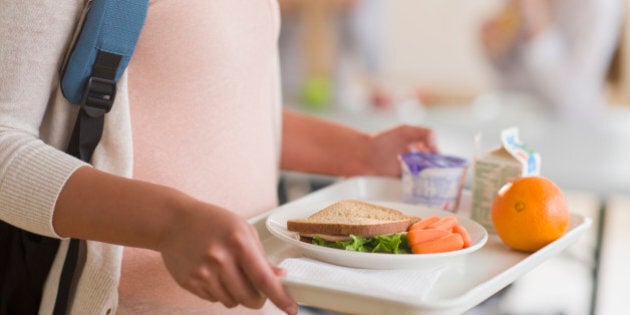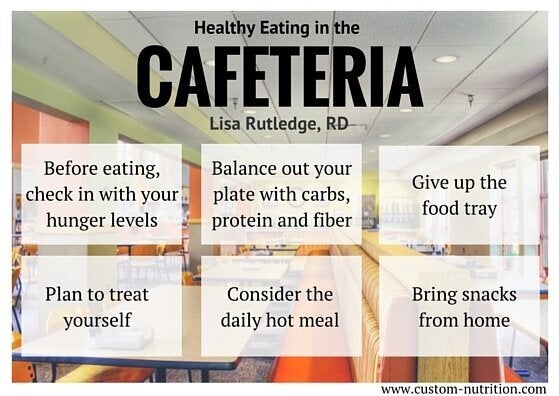
Cafeterias are not often seen as healthy places to eat. With build your own pizza stations and meals combos that beg you to include an appetizers and dessert, it can seem hard to keeps meals balanced and appropriate for your hunger levels. It's not easy navigating through the many choices in a cafeteria setting. On top of that, throw in the stress of assignments and exams and it can feel like the perfect storm for over eating and emotional eating.
One note on over eating: rather than beating yourself up about it, try understanding why you are over eating. Often it can be a way to cope with emotions. We all need to find a way to comfort ourselves in hard time, and for some people food is the easiest way to do it. Rather than feeling guilty for overeating, try finding other ways to reduce those negative emotions. Strategies other than food are likely better at easing anxiety or stress than food.
Whether this is your first or last semester of university or college, or the work cafeteria you struggle with, if you are looking for ways to eat better from the cafeteria, we've got you covered! Here are 6 tips you can use to help you make healthy choices in your cafeteria:
- Before walking into the cafeteria, take a deep breath and check in with your hunger levels. The stress of running between classes or completing work projects can make it hard to hear hunger levels. Before getting close to the food, ask yourself "how hungry am I?". Using a scale to rate you hunger can help you put that intangible feeling into context. For example, use a scale from 1 to 10 where 1 means you are starving and 10 means you are overstuffed. Use your level of hunger to dictate how much food you need. The more you practice listening to and interpreting your level of hunger, the better you will become in translating that feeling into how much food you need. For example, on a day when you are feeling your hunger is around a 4 on the scale, you'll need more food (likely a full meal) than when it is a 7 (likely a small snack). Remember, it is always best to include a snack later on than to overeat now to avoid being hungry later.
- Balance out your plate with the three important nutrients: carbs, protein and fiber. Try to fill 1/2 of your plate with veggies, 1/4 to a protein rich food and the last ¼ to a starchy food. This balance will help your body feel energized, full for longer (versus just a salad or just a grilled cheese sandwich) and best of all is super satisfying- mentally and physically. If you have the options, choosing whole wheat/whole grain carbs like brown rice quinoa can also keep you feeling fuller longer.
- Try giving up the food tray. By forgoing a food tray and taking only what you can hold in your hands, you naturally limit how much you can buy (and ultimately eat!). This not only helps to cut down on overeating but you'll likely spend less.
- Plan to treat yourself. Planning to enjoy a treat like fries or a dessert can actually help you eat healthier overall. Knowing that you'll be enjoying a special food sometime soon can help motivate you to focus on more nutritious foods today. Also, this helps enormously with reducing the intensity of cravings of these fun foods.
- Take a look at the daily hot meal. Often it is a balance of vegetable, protein and carbs AND is usually a cheaper choice over the salad bar, panini and burger stations. If it comes with too much food for your level of hunger, try saving some for later on in the day or for tomorrow's lunch.
- Bring snacks from home. Nothing that hijacks good intentions to eat well more than extreme hunger. Even with the best intentions to eat less or to choose more wisely, being too hungry while deciding what to eat is a huge barrier. Having a few healthy snacks on hand like yogurt or fruit can help calm hunger in the morning before lunch. Including a snack in the afternoon can help you eat portions that are more in accordance with your hunger levels at lunch- since you don't have to worry about what to do if hunger strikes in the afternoon.
.Using a scale to rate you hunger can help you put that intangible feeling into context.
Knowing that you'll be enjoying a special food sometime soon can help motivate you to focus on more nutritious foods today.
What are your favorite tips for eating well in a cafeteria?
